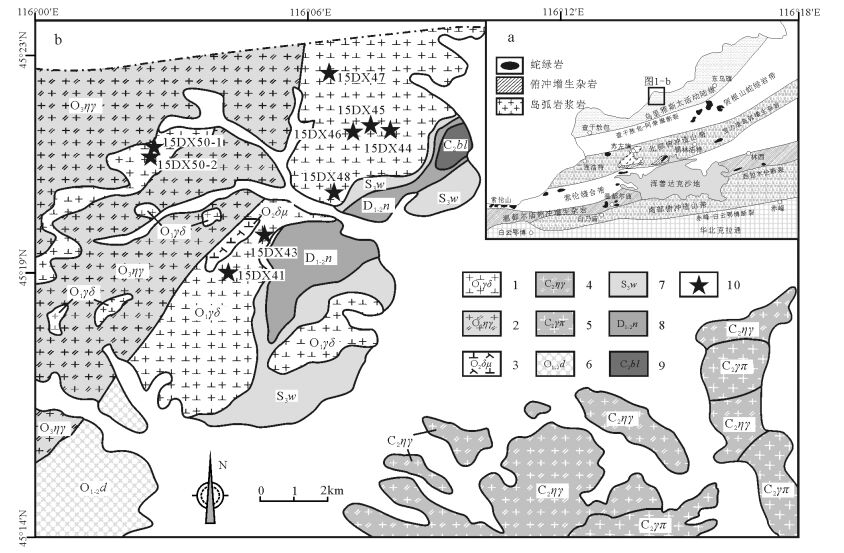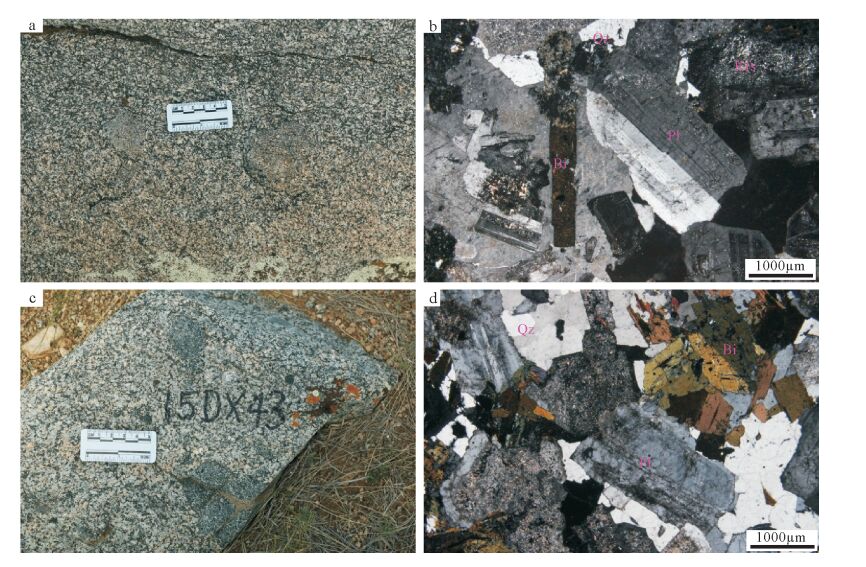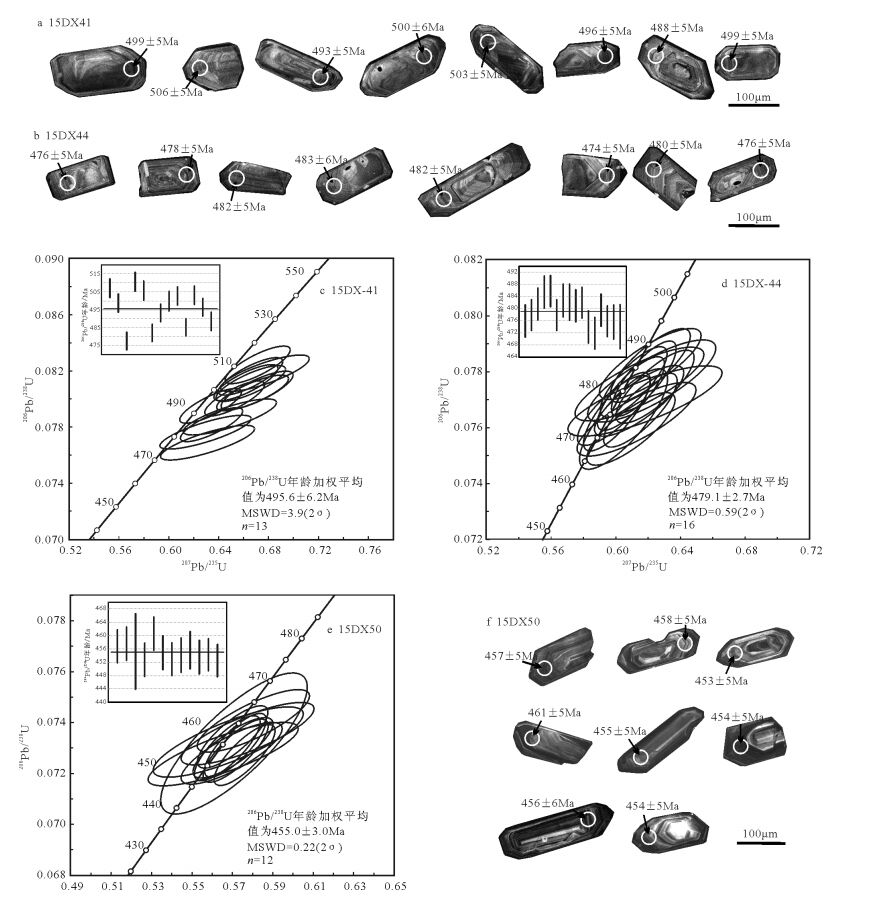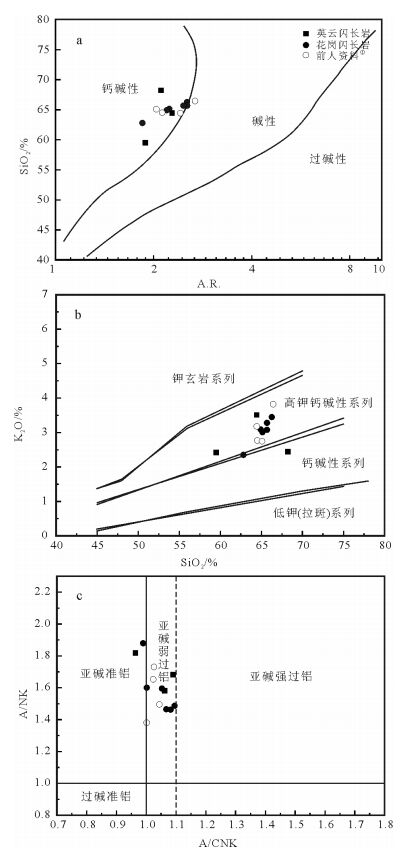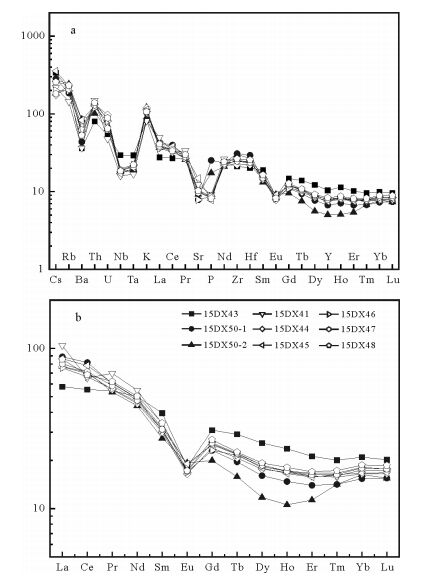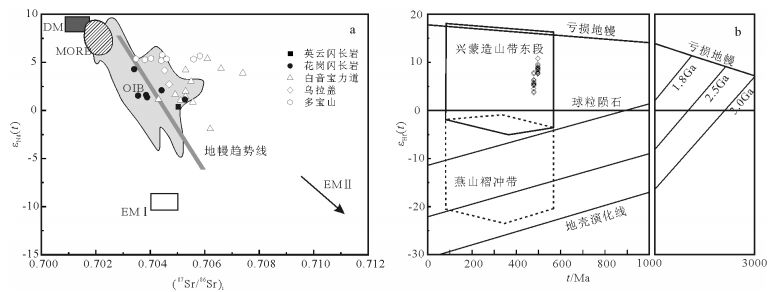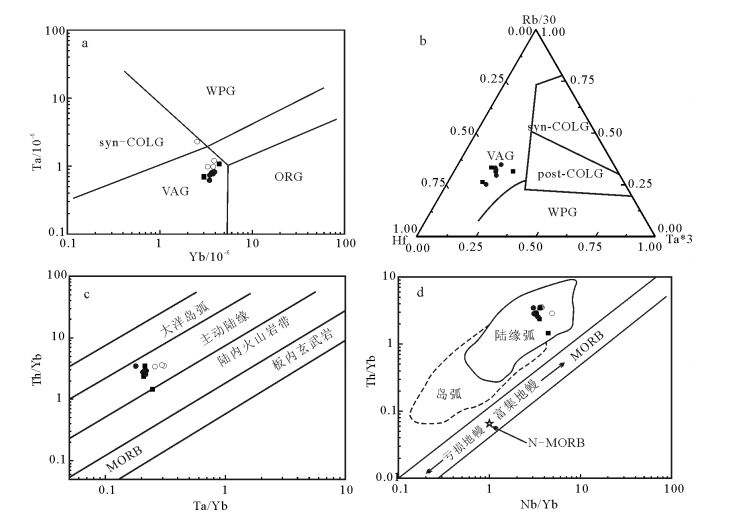Petrogenesis of the Early Paleozoic Jiergalangtu pluton in Inner Mongolia:Constraints from geochronology, geochemistry and Nd-Hf isotopes
-
摘要:
兴蒙造山带北缘断续分布的早古生代岩浆岩带,对古生代构造格局恢复及造山带演化研究具有重要意义。阿巴嘎旗北部吉尔嘎郎图岩体位于该岩浆岩带中段,为带内最大的早古生代复式侵入体。LA-ICP-MS锆石U-Pb定年表明,吉尔嘎郎图岩体早期花岗闪长岩单元成岩年龄为455.0~495.6Ma。在主量元素组成上,岩体SiO2含量中等(59.49%~68.22%),贫铁、镁,K2O/Na2O值(0.64~0.85)小于1,A/CNK=0.96~1.09,整体具有亚碱、弱过铝特征。稀土及微量元素方面,岩体富Cs、Rb、Th、U、Pb,亏损Ba、Sr、P及高场强元素Nb、Ta等,稀土元素总量中等,具有弱负Eu异常(δEu=0.52~0.82)。Sr-Nd-Hf同位素分析结果显示,岩体具有亏损的同位素组成,(87Sr/86Sr)i=0.7053~0.7034,εNd(t)=0.39~4.29,2件Hf同位素样品εHf(t)均为正值,分别为εHf(t)=7.6~10.8和εHf(t)=3.7~7.9。岩石地球化学、年代学及Sr-Nd-Hf同位素综合分析表明,吉尔嘎郎图岩体是早古生代古亚洲洋沿苏左旗-锡林浩特一线向北俯冲背景下,遭受了俯冲板片析出流体交代作用影响的新生下地壳部分熔融的产物,后期由于弧后拉张、贺根山洋盆打开与主体岛弧带分离,最终随着古亚洲洋的整体闭合,形成了与俯冲带彼此分隔的格局。
Abstract:Early Paleozoic granites are distributed on the northern margin of Xingmeng orogenic belt discretely, and the genesis of these granites has important implications for the reconstruction of regional Paleozoic tectonic setting and orogenic evolution. Jier-galangtu pluton outcropped in northern Abag Banner and located in the middle of the early Paleozoic granite belt is the biggest com-posite pluton in the granite belt. Zircon LA-ICP-MS U-Pb dating shows that the early stage of the pluton was emplaced during 455.0~495.6Ma. Geochemically, the Jiergalangtu granites show moderate SiO2 values (59.49%~68.22%) and depletion of magnesium and iron, with K2O/Na2O ratios less than 1 (0.64~0.85) and A/CNK values being 0.96~1.09; in addition, most of the samples present subalkaline and weak per-aluminous signature. The trace element data of these rocks display enrichment of Cs, Rb, Th, U, Pb and depletion of Ba, Sr, P and HFSE such as Nb, Ta, the pluton exhibits indistinct negative europium anomalies(δEu=0.04~0.25) with moderate total REE content. Jiergalangtu pluton shows depleted isotopic compositions, (87Sr/86Sr)i=0.7053~0.7034, εNd(t)=0.39~4.29, and both samples for Hf isotopic analysis have positive εHf(t) values, being 7.6~10.8 and 3.7~7.9 respectively. Integrated geochemical, geochronology and Sr-Nd-Hf isotopic data suggest that the Jiergalangtu granites were generated in early Paleozoic and resulted from the subduction of Paleo-Asian Ocean along Sunid-Xilinhot. The granites were formed by partial melting of juvenile crust which was modified by subduction slab fluids. The back-arc extension and opening of Hegenshan Ocean possibly resulted in the separation of Jiergalagntu pluton from predominant Sunid-Xilinhot island arc. Along with the closure of Paleo-Asian Ocean, the pluton ultimately occurred on the northern margin of Xingmeng orogenic belt and was separated from the subduction zone by He-genshan ophiolite complex.
-
华南地区是中国重要的有色、稀有和贵金属矿产资源产地,也是中国乃至全球大密度成矿区[1],目前研究程度较高[2-15]。粤东地区位于华南东南部(图 1),为东南沿海锡、钨、铜、铅锌矿产的重要产地,沿莲花山深大断裂带发育大量的锡、钨、铜、银、金多金属矿床(点),构成著名的莲花山锡多金属成矿带(图 1)。新寮岽铜多金属矿是近年来在粤东地区新发现的一个矿床,目前研究程度较低,尚未见相关报道,仅笔者对矿床中的绿泥石进行了相关研究[17]。新寮岽铜矿成因类型为斑岩型,本次选择与成矿关系密切的石英闪长岩为研究对象,利用高精度的分析测试手段,深入研究该岩体的岩相学、年代学、同位素地质学和岩石地球化学特征,并探讨其岩石成因。这不仅为进一步阐明成岩与成矿关系提供了依据,也有助于粤东地区区域成岩成矿规律理论研究,更为重要的是,对于研究矿床成因和下一步找矿勘探具有重要的理论和现实意义。
![]() 图 1 粤东地区地质略图(据参考文献[16]修改)Figure 1. Schematic geological map of eastern Guangdong Province
图 1 粤东地区地质略图(据参考文献[16]修改)Figure 1. Schematic geological map of eastern Guangdong Province1. 地质背景
粤东地区位于南岭东西向构造-岩浆带和中国东南沿海火山岩带的交会部位[18-19],整体上属于华南褶皱系,是环太平洋构造域的一个重要组成部分。粤东地区出露的地层比较简单,主要为上三叠统小坪组和下侏罗统金鸡组砂页岩及第四系沉积物。区内岩浆活动强烈,侵入岩多为燕山期花岗闪长岩、花岗岩和喜马拉雅期基性橄榄岩、玄武岩,喷出岩主要为晚侏罗世火山熔岩、次火山岩,其中尤以中生代岩浆活动最为频繁,徐晓春等[19]称之为I-S过渡型花岗质火山-侵入杂岩。区内断裂构造发育,主要由北东向海丰-丰顺断裂、普宁-潮州断裂及惠来-饶平断裂构成莲花山深大断裂带的主体,其次还有一些次级断裂,这些断裂系统控制着粤东地区岩浆活动及其矿床(点)的空间分布(图 1)。
新寮岽铜多金属矿区位于揭阳市揭东县与梅州市丰顺县交界处,区域上位于粤东隆起区西缘北东向新华夏系莲花山断裂挤压带的南东侧(图 1)。矿区出露地层比较简单(图 2),主要为侏罗系和第四系,其中下侏罗统长埔组为矿床的赋矿围岩。下侏罗统长埔组下段岩性为粉砂岩和泥质粉砂岩,长埔组上段岩性为泥质粉砂岩,偶夹长石石英砂岩;第四系出露全新统莲下组洪、冲积层。
区内岩浆活动强烈,主要出露燕山期花岗岩类。燕山三期中粗粒黑云母花岗岩主要出露于矿区东北部和西南部,燕山四期石英闪长岩出露于矿区中部及东南部,该岩体与成矿关系密切。此外,在矿区的中部和南部见有几条时代不明的辉绿岩脉和英安玢岩脉。
矿区构造以断裂构造为主。由于处于区域性莲花山断裂构造带的南东侧,在区域构造运动的影响下,矿区发育规模大小不等的、以北东向和近东西向为主的断裂。
新寮岽铜多金属矿床矿体主要赋存于石英闪长岩体与围岩的接触带或围岩裂隙中,局部产在石英闪长岩体内。因此,在空间上,石英闪长岩与成矿关系密切,是新寮岽矿床的成矿母岩。矿石呈浸染状、细脉浸染状、细网脉状产出,主要金属矿物有黄铜矿、黄铁矿、毒砂、辉银矿、辉钼矿等,非金属矿物主要为石英、方解石、绿泥石、绢云母、高岭石等。矿床围岩蚀变主要有硅化、绢云母化、绿泥石化、黑云母化、碳酸盐化、高岭石化等,尤以硅化和绿泥石化最为普遍,并与矿化关系密切。一般绿泥石化较强的地段,矿化亦强,反之矿化较弱。
2. 样品特征及分析方法
2.1 样品特征
用于锆石U-Pb同位素测定的石英闪长岩样品(XLDY-005)采自新寮岽铜多金属矿区,地理坐标为北纬23°37′43.2″、东经116°07′57.9″。岩石新鲜面呈灰白色,自形-半自形中细粒花岗结构、块状构造(图 3-a),野外定名为灰白色中细粒石英闪长岩。组成岩石的主要矿物为斜长石、钾长石、石英、普通角闪石和黑云母。副矿物主要有榍石、锆石、磷灰石、磁铁矿等,尤其是磁铁矿含量较多,此外还可见少量次生矿物,如方解石、绢云母、绿泥石等,局部可见星点状分布的硫化物。其中斜长石自形程度较好,呈半自形板状,聚片双晶发育(图 3-c),粒径多集中在1~2mm之间,含量约55%,部分斜长石可见环带构造(图 3-d),少量斜长石发生高岭石化。石英呈他形粒状充填在斜长石颗粒间或交代溶蚀斜长石(图 3-d),粒径多为0.1~0.5mm,含量约15%。普通角闪石呈他形,解理不清晰,粒径多为1~2mm,含量较少,约占15%。黑云母多呈自形片状,粒径0.3~1mm,含量约10%。其他矿物约占5%。
2.2 分析方法
石英闪长岩中锆石的挑选及岩石探针片磨制在北京大学碎样室和磨片室完成。其中,锆石分选采用常规方法,即将石英闪长岩原岩粉碎至300μm左右,经淘洗去除轻矿物、富集重矿物,再经磁选和重液分选后,在双目镜下进一步挑选出晶形、透明度和色泽较好的锆石颗粒。用环氧树脂将选得的锆石晶体制作成样品靶,待靶固结后打磨并抛光至锆石中心暴露。然后拍摄阴极发光(CL)、透射光和反射光照片,其中锆石CL照片在北京锆年领航科技有限公司实验室拍摄。实验中,根据3种图像选择合适的锆石晶体位置进行U-Pb定年和Hf同位素分析。
LA-ICP-MS锆石U-Th-Pb同位素测定在南京大学内生金属矿床成矿机制研究国家重点实验室完成。激光剥蚀系统为New Wave公司生产的UP213型,ICP-MS型号的Agilent 7500a型,采用氦作为剥蚀物质的载气,通过直径3mm的PVC管将剥蚀物质传送到ICP-MS,并在进入ICP-MS之前与氩气混合,形成混合气。实验中采用剥蚀直径为25μm的激光束斑,激光脉冲频率为5Hz,剥蚀时间50s,背景扫描时间40s。详细的分析方法和流程见黄卉等[20]。年龄计算及U-Pb谐和图的绘制用Isoplot程序3.0版完成[21]。
锆石Hf同位素分析在中国地质科学院矿产资源研究所MC-ICP-MS实验室完成,所用仪器为Finnigan Neptune型MC-ICP-MS及与之配套的Newwave UP 213激光剥蚀系统。激光剥蚀直径为55μm,测定时使用锆石标样GJ1和Plesovice作为参考物质,分析点与U-Pb同位素分析点位置相同或相近。相关仪器运行条件及详细分析流程见侯可军等[22]。分析过程中,锆石标准GJ1的176Hf/177Hf测试加权平均值为0.282007±0.000007(2σ,n=36),与文献报道值[22-23]在误差范围内完全一致。
单矿物斜长石微区剖面成分分析及黑云母化学成分分析在中国地质科学院矿产资源研究所电子探针室完成。测试仪器为JEOL-JXA-8230型电子探针,加速电压为15kV,加速电流10nA,束斑直径5μm,分析精度为0.001%。具体方法为:选取典型岩石样品磨制成抛光探针片,在光学显微镜下观察并圈定待测矿物,然后对探针片进行喷碳处理,利用电子探针显微分析仪选取矿物晶形完整、表面干净处进行测试分析。
全岩主量、微量和稀土元素均在长安大学成矿作用与动力学实验室测定。主量元素采用XRF分析完成,分析误差小于5%。微量和稀土元素(REE)分析采用HF+HNO3密封溶解,加入Rh内标溶液后转化为1% HNO3介质,以ICP-MS(USA ThermoElectron Co.X7型)测定,详细操作方法及原理参考Qi等[24]。REE含量测试误差小于7%,其余微量元素的分析误差一般小于10%。
3. 分析结果
3.1 锆石U-Th-Pb同位素
锆石均为无色,自形-半自形,近等轴状或长柱状,长宽比多介于1.5~1之间,个别可达3。从阴极发光图像(图 4)看,锆石内部结构清晰,多数锆石具有较明显的振荡环带,部分锆石具有扇形分带结构,可能是锆石结晶时外部环境的变化导致各晶面的生长速率不一致造成的[25]。从所测锆石的同位素比值和年龄数据(表 1)可以看出,25个分析测点的Th含量变化范围为534×10-6~5470×10-6,平均值为2448×10-6,U含量变化范围为670×10-6~2603×10-6,平均值为1720×10-6,在Th-U图解(图 5-a)上,两者呈正相关,锆石Th/U值介于0.66~2.17之间(一般岩浆锆石Th/U>0.4,变质锆石Th/U<0.1)。以上特征表明,锆石属典型的岩浆锆石。
表 1 新寮岽铜多金属矿区石英闪长岩(XLDY-005)LA-ICP-MS锆石U-Th-Pb同位素测定结果Table 1. LA-ICP-MS zircon U-Th-Pb isotopic data of the quartz-diorite (XLDY-005)from the Xinliaodong Cu polymetallic ore district测点号 含量/10-6 Th/U 207Pb/206Pb 207Pb/235U 206Pb/238U 208Pb/232Th 207Pb/206Pb 207Pb/235U 206Pb/238U 208Pb/232Th Th U 比值 1σ 比值 1σ 比值 1σ 比值 1σ 年龄/Ma 1σ 年龄/Ma 1σ 年龄/Ma 1σ 年龄/Ma 1σ 1 1122 880 1.3 0.0491 0.0016 0.1749 0.0056 0.0258 0.0004 0.0077 0.0018 153 75 164 5 164 2 155 35 2 1112 1677 0.7 0.0508 0.0017 0.1737 0.0056 0.0248 0.0004 0.0130 0.0069 230 75 163 5 158 2 260 137 4 3523 2535 1.4 0.0494 0.0014 0.1727 0.0049 0.0253 0.0004 0.0126 0.0060 168 65 162 4 161 2 253 120 6 2730 2603 1.1 0.0495 0.0011 0.1726 0.0038 0.0253 0.0004 0.0110 0.0042 173 51 162 3 161 2 222 83 7 2810 1771 1.6 0.0491 0.0012 0.1746 0.0042 0.0258 0.0004 0.0092 0.0029 154 56 163 4 164 2 185 58 8 2918 1687 1.7 0.0496 0.0023 0.1719 0.0079 0.0251 0.0005 0.0110 0.0067 177 106 161 7 160 3 220 134 9 2231 1398 1.6 0.0492 0.0014 0.1680 0.0047 0.0248 0.0004 0.0093 0.0032 156 64 158 4 158 2 186 65 11 2717 2085 1.3 0.0496 0.0013 0.1713 0.0045 0.0251 0.0004 0.0078 0.0023 174 60 161 4 160 2 157 46 12 1756 1545 1.1 0.0494 0.0014 0.1742 0.0050 0.0256 0.0004 0.0080 0.0025 168 66 163 4 163 2 162 51 13 1502 1130 1.3 0.0499 0.0015 0.1726 0.0052 0.0251 0.0004 0.0077 0.0023 188 70 162 5 160 2 155 47 14 3708 2048 1.8 0.0497 0.0021 0.1707 0.0070 0.0249 0.0004 0.0078 0.0039 180 95 160 6 159 3 157 79 15 2575 1924 1.3 0.0512 0.0016 0.1799 0.0056 0.0255 0.0004 0.0114 0.0059 248 71 168 5 162 2 229 118 17 2354 1978 1.2 0.0499 0.0016 0.1721 0.0055 0.0250 0.0004 0.0099 0.0053 192 74 161 5 159 2 199 107 18 5470 2521 2.2 0.0501 0.0012 0.1741 0.0042 0.0252 0.0004 0.0080 0.0013 201 56 163 4 160 2 160 27 20 4248 2491 1.7 0.0501 0.0011 0.1740 0.0038 0.0252 0.0004 0.0089 0.0015 198 51 163 3 160 2 180 30 21 2369 1513 1.6 0.0512 0.0011 0.1785 0.0038 0.0253 0.0004 0.0089 0.0015 248 48 167 3 161 2 178 30 22 534 725 0.7 0.0487 0.0020 0.1725 0.0071 0.0257 0.0004 0.0084 0.0014 132 94 162 6 164 3 168 29 23 2953 1737 1.7 0.0507 0.0013 0.1772 0.0044 0.0253 0.0004 0.0087 0.0015 229 56 166 4 161 2 176 29 24 2223 2341 1.0 0.0503 0.0009 0.1777 0.0032 0.0256 0.0004 0.0089 0.0015 207 41 166 3 163 2 180 30 26 1512 1187 1.3 0.0509 0.0027 0.1790 0.0092 0.0255 0.0005 0.0095 0.0016 237 117 167 8 162 3 192 33 27 919 670 1.4 0.0501 0.0031 0.1741 0.0106 0.0252 0.0005 0.0087 0.0015 201 138 163 9 160 3 174 30 28 2931 1592 1.8 0.0521 0.0013 0.1793 0.0043 0.0249 0.0004 0.0087 0.0015 291 54 168 4 159 2 175 29 29 958 1096 0.9 0.0499 0.0014 0.1747 0.0049 0.0254 0.0004 0.0092 0.0016 188 65 163 4 162 2 184 31 30 4156 2260 1.8 0.0492 0.0010 0.1709 0.0035 0.0252 0.0004 0.0086 0.0014 158 48 160 3 160 2 172 29 31 1860 1615 1.2 0.0508 0.0011 0.1751 0.0039 0.0250 0.0004 0.0086 0.0015 232 50 164 3 159 2 173 29 因本次的样品较年轻,故锆石的年龄采用206Pb/238U年龄[26]。在石英闪长岩样品中的31个分析点有6个分析点(XLDY-005-3、XLDY-005-5、XLDY-005-10、XLDY-005-16、XLDY-005-19、XLDY-005-25)谐和度较低,可能测点在残留锆石上年龄较老或所测区域跨越不同世代的晶域或跨越了颗粒边缘,因此在年龄统计时舍去这6个点的分析结果,剩余25个数据点的分析结果在谐和图上组成密集的一簇(图 5-b),206Pb/238U年龄加权平均值为161±1Ma(MSWD=0.57),代表了石英闪长岩的形成年龄。
3.2 地球化学特征
新寮岽铜多金属矿区石英闪长岩全岩地球化学分析结果及相关参数见表 2。
表 2 新寮岽铜多金属矿区石英闪长岩主量、微量和稀土元素分析结果及锆石饱和温度Table 2. Major, trace and rare earth elements data of the quartz-diorite from the Xinliaodong Cu polymetallic ore district and zircon saturation temperatures样品号 XLD05001 XLD05002 XLD05003 XLD05004 XLD05005 XLD05006 XLD05007 SiO2 57.63 58.07 57.32 57.56 57.57 57.46 58.14 TiO2 0.88 0.95 0.99 0.92 0.98 0.92 0.94 Al2O3 16.30 16.53 15.88 16.21 16.40 16.06 16.23 TFe2O3 7.12 7.67 7.81 7.39 7.48 7.55 7.33 MnO 0.12 0.13 0.18 0.12 0.22 0.15 0.34 MgO 4.56 4.91 4.63 4.58 4.55 4.64 4.53 CaO 6.76 6.68 6.12 6.43 6.17 6.64 6.02 Na2O 2.52 2.61 2.36 2.56 2.56 2.39 2.40 K2O 2.01 1.38 2.69 2.29 1.62 2.35 2.45 P2O5 0.18 0.18 0.18 0.18 0.19 0.18 0.18 烧失量 1.19 1.82 1.23 0.99 1.73 0.89 0.92 总量 99.27 100.93 99.39 99.23 99.47 99.23 99.48 σ 1.40 1.06 1.78 1.62 1.20 1.55 1.55 A/CNK 0.88 0.92 0.89 0.88 0.95 0.87 0.93 A/NK 2.58 2.86 2.34 2.42 2.75 2.48 2.46 DI 45.13 43.39 46.72 45.45 45.28 46.11 47.20 Na 2O+K2O 4.53 3.99 5.05 4.85 4.18 4.74 4.85 K2O/Na2O 0.80 0.53 1.14 0.89 0.63 0.98 1.02 Li 17.49 27.38 20.19 19.87 22.01 17.91 25.99 Be 1.56 1.56 1.57 1.58 1.82 1.56 1.76 Sc 21.05 22.77 21.52 20.91 20.85 20.70 19.78 V 151.0 152.1 147.8 148.8 160.6 148.4 144.3 Cr 150.6 155.1 140.3 135.7 133.7 138.3 127.4 Co 24.06 26.02 22.25 22.70 26.46 23.51 19.62 Ni 45.27 41.05 37.90 36.77 41.77 40.95 33.57 Cu 17.53 21.80 22.81 22.84 40.28 20.89 9.30 Zn 112.0 99.63 164.5 106.7 196.6 125.6 171.3 Ga 20.18 21.06 20.25 20.31 21.70 19.71 19.43 Rb 78.85 56.33 122.6 112.8 63.67 96.68 89.78 Sr 361.6 374.8 349.1 336.0 398.5 300.0 298.9 Y 19.72 20.62 20.29 20.58 21.41 20.98 19.90 Zr 180.2 22.98 53.97 205.4 214.4 162.8 160.7 Nb 9.16 9.42 9.84 9.68 11.20 9.24 9.20 Cd 0.29 0.17 0.53 0.79 1.22 0.51 0.60 In 0.23 0.14 1.27 0.27 0.12 0.11 0.14 Cs 7.25 3.89 5.84 15.13 5.69 11.90 10.63 Ba 457.8 392.8 590.3 416.6 670.0 412.6 502.9 Hf 4.24 0.68 1.57 4.91 5.21 3.92 3.98 Ta 0.64 0.67 0.71 0.71 0.78 0.65 0.67 Pb 12.44 11.31 18.03 52.45 111.1 17.66 114.3 Bi 0.74 0.23 4.66 2.60 1.80 0.30 0.26 Th 8.61 10.31 8.86 9.95 9.76 9.43 9.53 U 2.56 2.78 2.78 3.20 3.00 2.68 3.16 La 23.59 26.73 24.49 26.56 27.15 25.03 21.34 Ce 50.13 54.87 51.94 56.28 56.92 53.19 45.80 Pr 5.89 6.62 6.16 6.59 6.75 6.28 5.49 Nd 23.45 25.93 24.76 25.92 26.82 25.04 22.65 Sm 4.58 5.04 4.90 4.93 5.13 4.84 4.56 Eu 1.16 1.17 1.25 1.14 1.20 1.14 1.14 Gd 4.83 5.25 5.13 5.17 5.42 5.14 4.83 Tb 0.67 0.73 0.72 0.71 0.75 0.72 0.68 Dy 3.78 4.05 3.98 3.99 4.16 4.02 3.83 Ho 0.75 0.79 0.78 0.79 0.82 0.80 0.76 Er 2.15 2.24 2.20 2.26 2.35 2.29 2.17 Tm 0.29 0.30 0.30 0.31 0.32 0.31 0.29 Yb 1.91 1.92 1.91 2.02 2.08 2.03 1.93 Lu 0.28 0.29 0.28 0.30 0.31 0.31 0.29 ΣREE 123.5 135.9 128.8 137.0 140.2 131.1 115.8 LREE 108.8 120.4 113.5 121.4 124.0 115.5 101.0 HREE 14.68 15.57 15.29 15.56 16.21 15.62 14.79 LREE/HREE 7.41 7.73 7.42 7.80 7.65 7.39 6.83 (La/Yb)N 8.84 9.98 9.21 9.43 9.38 8.84 7.93 δEu 0.75 0.69 0.76 0.68 0.69 0.69 0.74 δCe 1.01 0.98 1.01 1.01 1.00 1.01 1.01 T/℃ 748 610 660 759 775 738 747 3.2.1 主量元素
新寮岽铜多金属矿区石英闪长岩主量元素分析结果(表 2)显示:岩石SiO2含量变化于57.32%~58.14%之间,平均为57.68%,属于中性岩范畴;Al2O3含量为15.88%~16.53%,TFe2O3含量较高,介于7.12%~7.81%之间,平均为7.48%,碱含量中等(Na2O+K2O=3.99%~5.05%,平均为4.60%)且相对富钠(K2O/Na2O=0.53~1.14,平均为0.86), 分异指数DI=43.39~47.20,平均为45.61;岩石高镁(MgO=4.53%~4.91%),铝饱和指数A/CNK=0.87~0.95,A/NK=2.34~2.86,为准铝质,在岩石A/CNK-A/NK图解(图 6-a)上亦投入准铝质范围,里特曼指数(σ)为1.06~1.78,属钙碱性系列,在SiO2-K2O图解(图 6-b)上落入高钾钙碱性系列和钙碱性系列区域,且落在钙碱性系列区域的投点靠近分界线。总之,岩石主量元素特征表明,石英闪长岩为镁质、碱含量中等、准铝质、钙碱性系列。
3.2.2 稀土及微量元素
新寮岽铜多金属矿区石英闪长岩的稀土元素测试结果见表 2。样品的稀土元素总量较低,介于115.8×10-6~140.2×10-6之间,平均为130.3×10-6。轻稀土元素(LREE)含量为101.0×10-6~124.0×10-6,平均值为114.9×10-6,重稀土元素(HREE)含量为14.68×10-6~16.21×10-6,平均值为15.39×10-6,轻、重稀土元素分馏明显,LREE/HREE值为6.83~7.80,平均为7.46,(La/Yb)N变化范围为7.93~9.98,平均为9.09,整体显示轻稀土元素富集、重稀土元素亏损的特征。所有样品不存在Ce异常(δCe平均为1.01),δEu范围为0.68~0.76,平均值为0.72,出现弱负Eu异常,表明岩体在成岩过程中发生过斜长石和富轻稀土矿物(磷灰石、独居石)的分离结晶作用。在稀土元素球粒陨石标准化图解(图 7-a)上,7件样品的稀土元素配分曲线极为相似,总体表现为轻稀土元素富集的右倾特征,其中重稀土元素Ho-Lu表现为平坦型。
![]() 图 7 新寮岽铜多金属矿区石英闪长岩稀土元素球粒陨石标准化图解(a)和微量元素原始地幔标准化蛛网图(b)(标准化值据参考文献[29])Figure 7. Chondrite-normalized REE patterns(a)and primitive mantlenormalized trace-element spider diagram(b)of quartz-diorite in the Xinliaodong Cu polymetallic ore district
图 7 新寮岽铜多金属矿区石英闪长岩稀土元素球粒陨石标准化图解(a)和微量元素原始地幔标准化蛛网图(b)(标准化值据参考文献[29])Figure 7. Chondrite-normalized REE patterns(a)and primitive mantlenormalized trace-element spider diagram(b)of quartz-diorite in the Xinliaodong Cu polymetallic ore district在微量元素原始地幔标准化蛛网图(图 7-b)上,石英闪长岩的微量元素分布较一致,表现为相对富集K、Rb、Ba、Th、U等大离子亲石元素,相对亏损Ta、Nb、Ti、P等高场强元素,其中P、Ti轻度亏损,说明磷灰石和钛铁矿已开始从岩浆中分离。此外,有2个样品(XLD05002和XLD05003)较其他5个样品Zr、Hf明显异常,可能是测试误差所致。
3.3 矿物化学特征
3.3.1 黑云母矿物化学
黑云母作为岩体中一种常见的暗色矿物,其成分特征反映了成岩时的地质环境和物理化学条件。因此,本次对石英闪长岩中的黑云母进行了电子探针分析(表 3),数据处理采用郑巧荣[30]电价差值法计算得出(以11个氧原子为基准)。由表 3可知,石英闪长岩中黑云母的MgO含量介于11.64%~16.85%之间,MF值介于0.56~0.79之间,均显示高镁、低铁的特点。马昌前等[31]对国内外文献中120个不同产状的黑云母成分特征进行研究后发现:退变质和固相线下交代作用成因的黑云母具有低Ti特征(Ti<0.20);进变质成因的黑云母Ti的变化范围较大,且Mg/(Mg+Fe2++Fe3+)值多大于0.55;而岩浆成因的黑云母具有中等的Ti含量(0.20<Ti<0.55),且Mg/(Mg+Fe2++Fe3+)值变化于0.30~0.55之间。本文中的黑云母Ti含量(表 3)介于0.23~0.30之间,Mg/(Mg+Fe2++Fe3+)值介于0.52~0.71之间,类似岩浆成因黑云母的成分特征,表明所测黑云母均为岩浆成因的原生黑云母,而非变质或固相线下交代成因的黑云母。在Foster[32]黑云母成分分类图解(图 8)中,所有样品点均落入镁质黑云母区域。
表 3 石英闪长岩黑云母电子探针分析结果及相关参数(以11个氧原子为基准)Table 3. Electron microprobe analyses of biotite from quartze-diorite(based on 11 oxygen atoms)测点号 XLD XLD XLD XLD XLD 测点号 XLD XLD XLD XLD XLD 05001-4-1 05001-4-2 05007-1-1 05007-1-2 05007-1-3 05001-4-1 05001-4-2 05007-1-1 05007-1-2 05007-1-3 SiO2 38.57 37.48 37.81 38.23 38.52 ArⅣ 1.14 1.15 1.20 1.12 1.12 TiO2 4.08 3.98 5.44 4.62 4.88 AlⅣ 0.10 0.06 0.00 0.04 0.03 Al2O3 14.24 13.49 13.20 13.09 12.96 Ti 0.23 0.23 0.30 0.26 0.27 FeOT 17.28 18.48 11.80 18.51 16.32 Fe3+ 0.20 0.27 0.29 0.20 0.17 MnO 0.17 0.14 0.32 0.53 0.51 Fe2+ 0.91 0.95 0.46 1.01 0.89 MgO 12.90 12.36 16.85 11.64 13.01 Mn 0.01 0.01 0.02 0.03 0.03 CaO 0.02 0.00 0.06 0.05 0.03 Mg 1.43 1.40 1.86 1.31 1.45 Na2O 0.12 0.05 0.09 0.17 0.20 Ca 0.00 0.00 0.00 0.00 0.00 K2O 9.01 8.78 9.06 9.04 8.99 Na 0.02 0.01 0.01 0.02 0.03 Cr2O3 0.22 0.20 0.25 0.24 0.20 K 0.85 0.85 0.86 0.87 0.86 总量 96.61 94.97 94.87 96.11 95.62 Cr 0.01 0.01 0.01 0.01 0.01 Si 2.86 2.85 2.80 2.88 2.88 MF 0.61 0.59 0.79 0.56 0.61 注: TFeO为全铁;FeO3+和Fe2+采用郑巧荣[30]的方法校正;MF=n(Mg)/n(Mg+Fe2++Mn) ![]() 图 8 黑云母成分分类(底图据参考文献[32])Figure 8. Classification of biotites
图 8 黑云母成分分类(底图据参考文献[32])Figure 8. Classification of biotites3.3.2 斜长石矿物化学
一般认为,斜长石的环带记录了岩浆熔体在结晶过程中物理、化学条件的变化,斜长石的环带模式与其形成的地质环境和地质过程密切相关;有学者还认为,斜长石环带的形貌反映了岩浆的冷却速率和晶体生长的其他物性[33-34]。因此,本次对石英闪长岩中发育环带结构的斜长石进行了电子探针分析(表 4)。由表 4可知,具环带结构的斜长石牌号An介于53.08~60.40之间,为拉长石(图 9)。斜长石环带成分从核部到边部依次为An(60.40)-An(60.12)-An(53.08)-An(56.16)-An(56.21)-An(55.91),说明此环带为一韵律环带。总体来看,An%从中心到边缘呈下降趋势,且在环带的核部与幔部交界处,An%突然降低,至边部又突然升高。据此推测,岩浆结晶早期为正常结晶,形成正环带,到中晚期出现异常结晶,导致斜长石成分发生突变,说明环带斜长石在中晚期处于不稳定的岩浆环境,可能受构造活动等的影响使压力反复变化及晶体上下运动[36]。
表 4 石英闪长岩中环带结构斜长石电子探针成分分析结果Table 4. Electron microprobe analyses of zoned plagioclase from quartz-diorite% 测点 XLD0500 XLD0500 XLD0500 XLD0500 XLD0500 XLD0500 6-2-1-1 6-2-1-2 6-2-1-3 6-2-1-4 6-2-1-5 6-2-1-6 边部→核部 SiO2 51.78 52.35 51.45 51.51 51.27 51.72 TiO2 0.06 0.11 0.10 0.05 0.07 0.02 Al2O3 32.12 31.02 30.31 30.62 30.93 29.83 FeO 0.14 0.30 0.24 0.32 0.36 0.35 MgO 0.03 0.01 0.02 0.00 0.01 0.00 Cr2O3 0.00 0.00 0.04 0.01 0.03 0.02 MnO 0.00 0.00 0.00 0.02 0.00 0.02 CaO 11.45 11.64 11.31 10.94 12.29 12.32 Na2O 4.84 4.81 4.70 5.12 4.32 4.32 K2O 0.22 0.30 0.27 0.35 0.28 0.21 P2O5 0.03 0.02 0.03 0.01 0.00 0.04 总量 100.72 100.59 98.48 98.96 99.57 98.92 Si 2.33 2.37 2.37 2.37 2.35 2.38 Al 1.71 1.65 1.65 1.66 1.67 1.62 Ca 0.55 0.56 0.56 0.54 0.60 0.61 Na 0.42 0.42 0.42 0.46 0.38 0.39 K 0.01 0.02 0.02 0.02 0.02 0.01 Ba 0.00 0.00 0.00 0.00 0.00 0.00 An 55.91 56.21 56.16 53.08 60.12 60.40 Ab 42.80 42.05 42.24 44.92 38.25 38.35 Or 1.29 1.74 1.60 2.00 1.64 1.25 注:数据处理采用Geokit软件计算得出 ![]() 图 9 斜长石分类图解及环带状斜长石成分剖面(底图据参考文献[35])Qtz—石英;Pl—斜长石Figure 9. Classification of feldspar and electron microprobe analyses of zoned plagioclase
图 9 斜长石分类图解及环带状斜长石成分剖面(底图据参考文献[35])Qtz—石英;Pl—斜长石Figure 9. Classification of feldspar and electron microprobe analyses of zoned plagioclase3.4 Hf同位素特征
在锆石U-Th-Pb测年的基础上,在锆石年龄分析点或附近进行了Hf同位素分析,分析结果见表 5。从表 5可以看出,除少数几个分析点外(11、20、30),大部分测点的176Lu/177Hf值均低于0.002,表明石英闪长岩中绝大多数锆石形成后放射性成因Hf积累较少,因此,本次测定的锆石176Lu/177Hf值能较好地反映其形成过程中Hf同位素的组成特征[38-39]。考虑到石英闪长岩fLu/Hf值介于-0.93~-0.98之间,明显小于硅铝质地壳的fLu/Hf值(-0.72)[40]和镁铁质地壳的fLu/Hf值(-0.34)[41],因此二阶段模式年龄更能反映其源区物质从亏损地幔被抽取的时间(或其源区物质在地壳的平均存留年龄)。
表 5 新寮岽铜多金属矿区石英闪长岩的锆石Hf同位素分析结果Table 5. Lu-Hf isotopic data of zircon from quartz-diorite in the Xinliaodong Cu polymetallic ore district测点号 t/Ma 176Yb/177Hf 176Lu/177Hf 176Hf/177Hf 2σ (176Hf/177Hf)i εHf(0) εHf(t) tDM1/Ma tDM2/Ma fLu/Hf 2 158 0.067067 0.001030 0.282631 0.000014 0.282627 -5.0 -1.6 881 1312 -0.97 6 161 0.075668 0.001280 0.282660 0.000013 0.282656 -4.0 -0.6 845 1245 -0.96 8 160 0.098102 0.001804 0.282678 0.000018 0.282672 -3.3 0.0 831 1210 -0.95 11 160 0.131231 0.002008 0.282756 0.000018 0.282750 -0.6 2.7 722 1033 -0.94 12 163 0.086784 0.001220 0.282664 0.000016 0.282660 -3.8 -0.4 838 1235 -0.96 13 160 0.050521 0.000718 0.282640 0.000017 0.282638 -4.7 -1.2 860 1288 -0.98 15 162 0.137709 0.001854 0.282669 0.000018 0.282664 -3.6 -0.3 844 1228 -0.94 17 159 0.114314 0.001635 0.282722 0.000018 0.282717 -1.8 1.5 764 1110 -0.95 20 160 0.116023 0.002127 0.282689 0.000021 0.282683 -2.9 0.4 822 1186 -0.94 21 161 0.096930 0.001492 0.282681 0.000015 0.282677 -3.2 0.2 819 1199 -0.96 22 164 0.034677 0.000682 0.282509 0.000033 0.282507 -9.3 -5.8 1042 1579 -0.98 23 161 0.125353 0.001983 0.282653 0.000014 0.282647 -4.2 -0.9 871 1266 -0.94 27 160 0.066417 0.001374 0.282672 0.000016 0.282668 -3.5 -0.2 829 1219 -0.96 29 162 0.119899 0.001741 0.282729 0.000016 0.282724 -1.5 1.9 755 1091 -0.95 30 160 0.161227 0.002218 0.282736 0.000019 0.282729 -1.3 2.0 756 1082 -0.93 31 159 0.061143 0.001105 0.282683 0.000015 0.282680 -3.1 0.2 808 1193 -0.97 注:εHf(t)={[(176Hf/177Hf)s-(176Lu/177Hf)s×(eλt-1)]/[(176Hf/177Hf)CHUR, 0-(176Lu/177Hf)CHUR×(et-1)]-1}×10000;TDM1=1/ λ×ln {1+[(176Hf/177Hf)s-(176Hf/177Hf)DM]/[(176Lu/177Hf)s-(176Lu/177Hf)DM]};TDM2=1/λ×ln{1+[(176Hf/177Hf)s, t-(176Hf/177Hf)DM, t]/[(176Lu/177Hf)C-(176Lu/177Hf)DM]}+t;s=sample, (176Hf/177Hf)CHUR, 0=0.282772, (176Lu/177Hf)CHUR=0.0332, (176Hf/177Hf)DM=0.28325, t为锆石结晶年龄,λ=1.867×10-11a-1, (176Lu/177Hf)C=0.015 本次所测石英闪长岩样品中锆石176Hf/177Hf值范围为0.282509~0.282756,由对应的测点年龄计算得到的Hf同位素初始比值(176Hf/177Hf)i为0.282507~0.282750,Hf同位素变化范围较宽,εHf(t)变化于-5.8~2.7之间,对应的两阶段模式年龄tDM2=1.03~1.58Ga,由二阶段Hf模式年龄(tDM2)和εHf(t)频率分布直方图(图 10)可以看出,εHf(t)主体在-1.0~0.0范围内,tDM2主体在1.2~1.3Ga范围内。
4. 讨论
4.1 岩体形成时代
本次获得的石英闪长岩锆石U-Pb年龄为161±1Ma(MSWD=0.57),与矿区花岗斑岩(锆石U-Pb年龄160±1Ma,另文发表)、黑云母花岗岩(锆石U-Pb年龄157±1Ma,另文发表)的锆石U-Pb年龄较一致,矿区在晚侏罗世发生过一次较明显的岩浆活动,但需要岩石地球化学及相关同位素分析等证据进一步确认。杨进辉(2014,个人报告)统计了粤东地区中生代花岗岩类的成岩时代,认为粤东地区中生代花岗岩类的形成时代主要集中在165~155Ma和142~135Ma两个阶段。本次获得的石英闪长岩的成岩年龄(161±1Ma)正好与165~155Ma这一阶段相吻合,应同属粤东地区该阶段岩浆侵入活动的产物。
4.2 成岩条件
锆石是花岗岩中结晶较早的矿物,Zr的分配系数受温度控制较明显, 其锆石饱和温度可近似为岩浆结晶温度,因此锆石饱和温度计用于岩浆温度的计算是一个有效的方法[42-43]。根据Watson等[37]提供的锆石溶解度-饱和温度的计算方法,用岩石主要元素及其Zr含量计算得出矿区石英闪长岩的锆石饱和温度平均为720℃。花岗质岩石中黑云母的化学成分受控于岩浆冷却结晶时的物理化学条件,因此,黑云母可以近似地指示岩浆冷却结晶时的物理化学状态。从黑云母Mg/(Mg+Fe)-Ti温度图解(图 11)中,可以估算本区石英闪长岩中新鲜黑云母的结晶温度范围大致为620~720℃,与计算的锆石饱和温度接近。
黑云母是花岗岩类岩石中常见的暗色造岩矿物之一,保存了岩石结晶时大量的地球化学信息。氧逸度可以反映氧化还原条件。前人研究指出,可以利用与磁铁矿、钾长石共生的黑云母的成分特征估算黑云母结晶时的氧逸度[45]。通过镜下观察可知,石英闪长岩中可见黑云母-磁铁矿-钾长石-石英共生组合,满足氧逸度使用条件,故在黑云母Fe3+-Fe2+-Mg图解(图 12)中,所有样品点均落在Fe3O4-Fe2O3缓冲线与Ni-NiO缓冲线之间,实验证明[47],在相同温度下,从Fe2SiO4-SiO2-Fe3O4缓冲线经Ni-NiO缓冲线,到Fe2O3-Fe3O4缓冲线,氧逸度系统升高,说明黑云母结晶时氧逸度较高。此外,由图 8可知,岩石中黑云母均为镁质黑云母,而黑云母富镁是岩浆高氧逸度的标志之一[46]。另外,根据前人研究[46, 48],氧逸度的变化受岩浆结晶时水逸度的控制,随着水逸度的升高氧逸度逐渐下降,可进一步得出本次研究的黑云母结晶时水逸度较低。云母的镁质率[MF=n(Mg)/n(Mg+Fe2++Mn)]可以作为区分长江深源系列和南岭浅源系列岩石的重要指标[49],MF>0.45表明岩体形成于深源环境。石英闪长岩中黑云母镁质率介于0.56~0.79之间,表明石英闪长岩形成于深源环境。
![]() 图 11 黑云母Mg/(Mg+Fe)-Ti图解(底图据参考文献[44])Figure 11. Mg/(Mg+Fe)-Ti diagram of biotites
图 11 黑云母Mg/(Mg+Fe)-Ti图解(底图据参考文献[44])Figure 11. Mg/(Mg+Fe)-Ti diagram of biotites![]() 图 12 黑云母Fe3+-Fe2+-Mg图解(底图据参考文献[46])Figure 12. Fe3+-Fe2+-Mg diagram of biotites
图 12 黑云母Fe3+-Fe2+-Mg图解(底图据参考文献[46])Figure 12. Fe3+-Fe2+-Mg diagram of biotites4.3 成岩物质来源
石英闪长岩主量元素显示富镁的特征(MgO=4.53%~4.91%),稀土元素球粒陨石标准化配分曲线表现为轻稀土元素富集的右倾型(LREE/HREE=6.83~7.80,(La/Yb)N=7.93~9.98),原始地幔标准化微量元素蛛网图显示,该岩体相对富集大离子亲石元素(K、Rb、Ba、Th、U等),亏损高场强元素(Ta、Nb、Ti、P等),岩石地球化学特征表明,岩体具有俯冲带岩浆岩的特征[50-51]。Nb、Ta、Ti等高场强元素的亏损,反映可能有富钛矿物的分离结晶,P的亏损则表明可能有磷灰石的分离结晶[52]。Ti的贫化表示岩浆物质有地壳物质的参与,因为Ti不易进入熔体而残留在源区。亏损P反映岩浆幔源的特点。Nb/Ta值对源区具有一定指示作用[53],本文7个石英闪长岩样品Nb/Ta值介于13.6~14.4之间,即介于下地壳(Nb/Ta=8.3)与亏损地幔(Nb/Ta>17.0)之间[29],暗示幔源组分的贡献。综上,岩石地球化学特征表明,石英闪长岩的源区既有幔源物质,又有壳源物质,推测其可能与俯冲洋壳部分熔融有关。
黑云母作为花岗质岩体中重要的暗色矿物,其化学成分是区分壳型、幔型、壳幔混源型花岗质岩体的有效手段[54]。通常情况下,典型壳源黑云母中MgO小于6%,幔源黑云母的中MgO大于15%[55],石英闪长岩黑云母中MgO介于11.64%~16.85%之间,表现为壳幔过渡性质。同样在黑云母物质来源判别图解(图 13)中,所有样品点均落入壳幔混源区域,并靠近壳源分界线。
![]() 图 13 黑云母物质来源判别图(底图据参考文献[56])Figure 13. Diagram for discrimination of material source of biotite
图 13 黑云母物质来源判别图(底图据参考文献[56])Figure 13. Diagram for discrimination of material source of biotite锆石化学性质稳定,抗风化能力强,Lu/Hf值低,不受部分熔融作用和分离结晶作用的影响,这使得锆石Hf同位素组成可以记录岩浆源区不同性质的原岩特征,成为讨论岩浆甚至是地壳演化及壳幔相互作用过程的重要工具。研究表明,不同地球化学储库具有明显不同的176Hf/177Hf同位素组成:亏损地幔和球粒陨石的176Hf/177Hf值较大(大于0.282772),εHf(t)值为零或正值;地壳及富集地幔的εHf(t)值则较小,且εHf(t)为负值[39-40]。本文所测石英闪长岩锆石176Hf/177Hf值介于0.282507~0.282750之间,平均值为0.282669,εHf(t)值变化于-5.8~2.7,二阶段模式年龄(tDM2)为1.03~1.58Ga,平均为1.2Ga,在Hf同位素演化图解(图 14)上,样品εHf(t)值落在球粒陨石演化线附近及下地壳区域,样品锆石Hf同位素组成的不均一性,指示石英闪长岩成岩源区为壳幔混源,岩体的形成可能与俯冲板片局部熔融并与楔形地幔橄榄岩相互作用有关,且岩浆上升侵位过程中混染了部分陆壳物质。
![]() 图 14 石英闪长岩的Hf同位素演化图解(底图据参考文献[57])(地壳派生物的谐和线为通过假定的平均大陆地壳176Lu/177Hf值为0.015计算得到)Figure 14. Hf isotope evolution diagram of quartz-dioriteⅠ—小于0.83Ga; Ⅱ—0.83~1.1Ga; Ⅲ—1.1~1.4Ga; Ⅳ—1.4~1.6Ga; Ⅴ—1.6~1.9Ga
图 14 石英闪长岩的Hf同位素演化图解(底图据参考文献[57])(地壳派生物的谐和线为通过假定的平均大陆地壳176Lu/177Hf值为0.015计算得到)Figure 14. Hf isotope evolution diagram of quartz-dioriteⅠ—小于0.83Ga; Ⅱ—0.83~1.1Ga; Ⅲ—1.1~1.4Ga; Ⅳ—1.4~1.6Ga; Ⅴ—1.6~1.9Ga由以上岩石地球化学特征、黑云母矿物化学特征及其锆石Hf同位素组成特征综合分析推断,矿区石英闪长岩成岩物质具有壳幔混合的特征,其可能为俯冲板片局部撕裂熔融,并与楔形地幔相互作用而成,岩浆上侵过程中有部分古老地壳物质混染。
4.4 成岩构造环境
中国华南地区分布大面积的中生代花岗岩类,这些花岗岩类的构造环境及其动力学背景,长期以来是众多学者研究的焦点[1, 4-5, 12]。虽然不同学者通过对华南花岗岩类地球化学、年代学、同位素的研究提出不同的构造模型,但大多数学者认为其与太平洋板块的俯冲有关。邓晋福等[58]认为,中国东部在燕山期发生了岩石圈-软流圈系统(LAS)大灾变事件,并识别出被扰动的LAS的2种类型,即在挤压造山环境下的岩石圈巨大减薄与巨大增厚作用。中生代晚期,古太平洋板块向欧亚板块的俯冲消减导致中国东部发生了大规模的中酸性岩浆侵位和火山喷发[59]。近年来, 岩浆岩、构造、矿床等多方面的证据表明, 华南在180~170Ma已经完成由特提斯构造域向滨太平洋构造域的转换[60-64],燕山期华南成岩成矿的构造背景可能与太平洋板块向西俯冲挤压碰撞有关[65-70]。中晚侏罗世(170~150Ma),南岭及其邻区大陆岩石圈以伸展背景为主,由于Izanagi板块向欧亚大陆持续低角度俯冲,于170~160Ma期间发生俯冲板片多处撕裂,形成I同熔型斑岩铜矿,160~150Ma期间由于俯冲板块开天窗,软流圈物质上涌到下地壳形成壳幔源型高分异花岗质岩石[1]。粤东地区作为太平洋板块与华南板块作用的前缘,不同于南岭地区的板内环境,其发生的岩浆活动应早于华南板块内部。刘鹏等[17]研究认为,粤东地区不仅发现190Ma左右太平洋板块开始俯冲时的岩浆活动,又有160Ma左右俯冲板片撕裂形成的火山-侵入岩和140Ma之后太平洋板块俯冲方向调整形成的火山-侵入岩。作为华南板块大陆边缘,粤东地区岩浆活动记录了从太平洋板块开始俯冲到俯冲板片撕裂,再到俯冲方向调整的整个事件过程。
因此,笔者认为,矿区晚侏罗世的石英闪长岩岩体形成于受太平洋板块俯冲作用控制的活动大陆边缘环境,其可能为俯冲板片局部撕裂熔融,并与楔形地幔相互作用而成。
Abdel-Rahman[71]认为,非造山带碱性花岗岩形成于高温、缺水环境,该环境不利于早期富铁矿物(磁铁矿、钛铁矿)结晶,所以晚期结晶的黑云母表现出高铁的特征;而造山带钙碱性花岗岩产于富水环境下,有利于早期富铁矿物的结晶,因此晚期结晶的黑云母表现出相对高镁、低铁的特点;因而利用黑云母的化学成分可以判断花岗质岩体的构造背景。在黑云母MgO-TFeO-Al2O3及Al2O3-MgO图解(图 15)中,石英闪长岩落入造山带钙碱性花岗岩区域,这与全岩地球化学数据得出的结论一致(石英闪长岩成分富集LILE,亏损Nb、Ta、Ti等特征,说明其具有典型俯冲带岩浆岩特征[50-51])。
![]() 图 15 黑云母构造环境判别图(底图据参考文献[71])A—非造山的碱性岩系;C—造山带钙碱性岩系;P—过铝质岩系Figure 15. Discrimination diagram of tectonic settings for biotite
图 15 黑云母构造环境判别图(底图据参考文献[71])A—非造山的碱性岩系;C—造山带钙碱性岩系;P—过铝质岩系Figure 15. Discrimination diagram of tectonic settings for biotite花岗岩类的微量元素组成明显受其成岩构造环境制约,在Batchelor[72]提出的R1-R2多阳离子图解(图 16)上,样品点落入活动板块边缘花岗岩区域。在Pearce等[73]提出的花岗岩构造环境判别图(图 17)上,样品点全部投影于火山弧花岗岩区域。通过以上岩石地球化学特征及岩石矿物化学特征,结合本区区域位置及其演化历史,推测石英闪长岩岩体可能形成于俯冲背景下的活动大陆边缘环境,是俯冲板片局部撕裂熔融,并与楔形地幔相互作用的结果。
![]() 图 16 石英闪长岩R1-R2多阳离子图解(底图据参考文献[72])1—地幔分异花岗岩;2—活动板块边缘花岗岩;3—碰撞后隆起花岗岩;4—造山晚期花岗岩;5—非造山花岗岩;6—同碰撞花岗岩;7—造山后的A型花岗岩Figure 16. R1 versus R2 multicationic diagram for quartz diorites
图 16 石英闪长岩R1-R2多阳离子图解(底图据参考文献[72])1—地幔分异花岗岩;2—活动板块边缘花岗岩;3—碰撞后隆起花岗岩;4—造山晚期花岗岩;5—非造山花岗岩;6—同碰撞花岗岩;7—造山后的A型花岗岩Figure 16. R1 versus R2 multicationic diagram for quartz diorites![]() 图 17 石英闪长岩构造环境判别图解(底图据参考文献[73])syn-COLG—同碰撞花岗岩;VAG—火山弧花岗岩;WPG—板内花岗岩;ORG—洋脊花岗岩Figure 17. Discrimination diagram for tectonic settings of quartz diorates
图 17 石英闪长岩构造环境判别图解(底图据参考文献[73])syn-COLG—同碰撞花岗岩;VAG—火山弧花岗岩;WPG—板内花岗岩;ORG—洋脊花岗岩Figure 17. Discrimination diagram for tectonic settings of quartz diorates5. 结论
(1)矿区石英闪长岩LA-ICP-MS锆石U-ThPb年龄为161±1Ma,与矿区出露的黑云母花岗岩、花岗斑岩及花岗闪长斑岩的成岩年龄较一致,为矿区晚侏罗世岩浆活动的产物。
(2)石英闪长岩在地球化学特征上显示,碱含量中等(Na2O+K2O=3.99%~5.05%,平均4.60%),岩石高镁(MgO=4.53%~4.91%),轻、重稀土元素分馏较明显,富集轻稀土元素及大离子亲石元素(K、Rb、Ba、Th、U),亏损重稀土元素和高场强元素(Nb、Ta、Ti、P),为准铝质、钙碱性系列岩石。
(3)石英闪长岩中黑云母属镁质黑云母,黑云母矿物化学特征表明岩体形成于深源环境,形成时氧逸度较高,水逸度较低,岩体成岩物质来源为壳幔混合源。
(4)石英闪长岩的Hf同位素组成变化范围较窄,εHf(t)变化于-5.8~2.7(主体在-1.0~0.0范围内)之间,tDM2=1.03~1.58Ga(主体在1.2~1.3Ga范围内),岩石地球化学、矿物化学及锆石Hf同位素特征综合分析推断,岩体的形成可能与俯冲板片局部撕裂熔融并与楔形地幔橄榄岩相互作用有关,且岩浆上侵过程中有部分陆壳物质混染,岩体可能形成于俯冲背景下的活动大陆边缘环境。
致谢: 实验测试中得到中国地质调查局天津地质调查中心李国占、刘文刚工程师的帮助和支持,论文写作得到中国地质调查局天津地质调查中心李惠民研究员的指导,在此表示由衷感谢。 -
表 1 吉尔嘎郎图岩体LA-ICP-MS锆石U-Th-Pb定年结果
Table 1 LA-ICP-MS zircon U-Th-Pb dating results of the Jiergalangtu granite pluton
点号 含量/10-6 Th/U 同位素比值 表面年龄/Ma Pb U 207Pb/235U 1σ 206Pb/238U 1σ 207Pb/206Pb 1σ 206Pb/238U 1σ 207Pb/235U 1σ 样品:15DX41;岩性:花岗闪长岩 15DX41-01 12 138 0.48 0.6772 0.0235 0.08183 0.00086 0.06002 0.00202 507 5 525 18 15DX41-03 18 207 0.58 0.6672 0.0190 0.08043 0.00084 0.06016 0.00162 499 5 519 15 15DX41-04 19 240 0.47 0.6311 0.0249 0.07689 0.00082 0.05953 0.00220 478 5 497 20 15DX41-05 16 179 0.52 0.6713 0.0172 0.08243 0.00088 0.05906 0.00146 511 5 522 13 15DX41-06 14 162 0.53 0.6656 0.0171 0.08161 0.00088 0.05915 0.00147 506 5 518 13 15DX41-07 29 346 0.65 0.6295 0.0242 0.07763 0.00080 0.05881 0.00223 482 5 496 19 15DX41-08 28 325 0.54 0.6336 0.0164 0.07951 0.00081 0.05780 0.00141 493 5 498 13 15DX41-09 27 296 0.67 0.6709 0.0191 0.08061 0.00091 0.06036 0.00150 500 6 521 15 15DX41-10 27 299 0.67 0.6657 0.0184 0.08110 0.00084 0.05953 0.00157 503 5 518 14 15DX41-11 24 280 0.61 0.6343 0.0165 0.07817 0.00080 0.05885 0.00148 485 5 499 13 15DX41-12 31 356 0.64 0.6618 0.0170 0.08116 0.00085 0.05914 0.00140 503 5 516 13 15DX41-15 20 231 0.60 0.6529 0.0158 0.08004 0.00082 0.05916 0.00138 496 5 510 12 15DX41-17 25 289 0.63 0.6490 0.0247 0.07872 0.00085 0.05980 0.00218 488 5 508 19 样品:15DX44;岩性:花岗闪长岩 15DX44-02 12 145 0.59 0.6153 0.0150 0.07662 0.00087 0.05824 0.00137 476 5 487 12 15DX44-03 12 141 0.54 0.6145 0.0182 0.07695 0.00083 0.05792 0.00165 478 5 486 14 15DX44-04 10 123 0.60 0.6147 0.0263 0.07756 0.00087 0.05748 0.00243 482 5 487 21 15DX44-05 11 136 0.56 0.6213 0.0164 0.07822 0.00087 0.05761 0.00148 485 5 491 13 15DX44-06 15 177 0.56 0.6214 0.0208 0.07827 0.00084 0.05758 0.00189 486 5 491 16 15DX44-07 12 153 0.52 0.6182 0.0315 0.07695 0.00083 0.05826 0.00291 478 5 489 25 15DX44-08 18 220 0.63 0.6174 0.0132 0.07775 0.00089 0.05759 0.00113 483 6 488 10 15DX44-09 17 206 0.62 0.6223 0.0262 0.07767 0.00097 0.05811 0.00228 482 6 491 21 15DX44-10 14 169 0.56 0.6243 0.0160 0.07746 0.00086 0.05846 0.00138 481 5 493 13 15DX44-11 15 178 0.58 0.6111 0.0137 0.07764 0.00083 0.05709 0.00121 482 5 484 11 15DX44-13 17 213 0.64 0.6129 0.0243 0.07630 0.00087 0.05826 0.00194 474 5 485 19 15DX44-15 12 156 0.63 0.6095 0.0180 0.07595 0.00086 0.05820 0.00164 472 5 483 14 15DX44-16 13 161 0.57 0.6094 0.0137 0.07722 0.00087 0.05724 0.00122 480 5 483 11 15DX44-17 16 211 0.52 0.5988 0.0149 0.07661 0.00082 0.05669 0.00136 476 5 476 12 15DX44-18 20 259 0.54 0.6007 0.0136 0.07657 0.00092 0.05690 0.00118 476 6 478 11 15DX44-19 19 244 0.54 0.6049 0.0180 0.07631 0.00118 0.05749 0.00156 474 7 480 14 样品:15DX50;岩性:英云闪长岩 15DX50-02 15 205 0.23 0.5702 0.0115 0.07343 0.00081 0.05631 0.00104 457 5 458 9 15DX50-06 9 131 0.17 0.5776 0.0217 0.07356 0.00081 0.05694 0.00215 458 5 463 17 15DX50-07 18 229 0.67 0.5708 0.0239 0.07318 0.00183 0.05658 0.00185 455 11 459 19 15DX50-08 12 163 0.42 0.5655 0.0245 0.07276 0.00082 0.05637 0.00225 453 5 455 20 15DX50-09 19 266 0.26 0.5804 0.0183 0.07407 0.00081 0.05684 0.00172 461 5 465 15 15DX50-10 25 334 0.43 0.5715 0.0101 0.07311 0.00083 0.05670 0.00089 455 5 459 8 15DX50-11 9 121 0.48 0.5697 0.0165 0.07279 0.00080 0.05676 0.00160 453 5 458 13 15DX50-12 26 374 0.15 0.5675 0.0107 0.07299 0.00084 0.05639 0.00099 454 5 456 9 15DX50-13 22 290 0.43 0.5680 0.0245 0.07323 0.00091 0.05625 0.00238 456 6 457 20 15DX50-14 22 303 0.47 0.5717 0.0106 0.07289 0.00082 0.05688 0.00100 454 5 459 9 15DX50-15 18 253 0.33 0.5703 0.0131 0.07300 0.00078 0.05666 0.00120 454 5 458 11 15DX50-16 22 294 0.42 0.5761 0.0099 0.07272 0.00079 0.05745 0.00091 453 5 462 8 表 2 吉尔嘎郎图岩体主量、微量和稀土元素含量
Table 2 Major, trace and rare earth element concentrations of the Jiergalangtu pluton
样号岩性 15DX43 15DX50-1 15DX50-2 15DX41 15DX44 15DX45 15DX46 15DX47 15DX48 英云闪长岩 花岗闪长岩 SiO2 59.49 68.22 64.43 62.80 66.27 65.68 65.68 65.13 64.92 TiO2 1.56 0.64 0.69 0.84 0.69 0.70 0.75 0.75 0.73 Al2O3 15.88 14.92 17.07 16.05 15.19 15.18 15.33 15.48 15.30 Fe2O3 3.09 1.68 1.73 1.84 2.39 2.52 2.11 1.69 2.99 FeO 5.00 2.54 2.79 3.63 2.08 2.52 2.69 3.02 2.01 MnO 0.14 0.07 0.08 0.10 0.08 0.10 0.09 0.05 0.09 MgO 2.77 1.28 1.36 2.26 1.46 1.74 1.62 1.67 1.62 CaO 4.23 2.63 2.89 4.20 2.11 1.99 2.01 2.73 3.12 Na2O 3.73 3.80 4.26 3.66 4.04 4.16 4.25 3.93 3.79 K2O 2.42 2.44 3.51 2.35 3.45 3.28 3.08 3.01 3.09 P2O5 0.18 0.52 0.36 0.19 0.17 0.16 0.18 0.18 0.17 LOI 0.95 1.91 0.96 1.68 1.83 1.68 1.92 2.02 1.95 ALK 6.15 6.24 7.77 6.01 7.49 7.44 7.33 6.94 6.88 A.R. 1.88 2.10 2.27 1.84 2.53 2.53 2.46 2.23 2.19 A/CNK 0.96 1.09 1.06 0.99 1.07 1.08 1.10 1.05 1.00 A/NK 1.81 1.68 1.58 1.87 1.46 1.46 1.48 1.59 1.60 Sc 27.70 15.60 17.30 17.50 17.90 19.00 18.70 17.70 18.00 V 243 60 64 105 72 76 80 79 80 Cr 22.90 17.30 19.10 32.50 18.60 21.00 20.60 21.60 26.30 Co 18.60 7.66 8.21 13.40 8.53 8.98 9.28 9.57 9.50 Ni 29.10 9.68 11.40 20.40 11.70 12.20 12.10 12.70 13.20 Cu 59.70 15.20 18.80 25.40 17.90 118.00 21.30 152.00 20.40 Zn 92.00 58.60 61.30 61.60 55.30 148.00 61.90 46.20 60.10 Ga 19.90 19.70 20.70 18.90 18.20 19.20 18.70 19.00 18.50 Cs 7.08 5.94 5.80 4.59 3.67 7.49 4.20 3.82 5.41 Rb 123 111 145 86 140 136 118 124 140 Ba 238 288 562 240 443 547 393 412 350 Th 6.37 11.20 8.04 11.90 10.60 10.10 9.58 10.30 11.10 U 1.07 1.70 1.31 0.97 1.97 1.58 1.64 1.80 1.32 Nb 19.40 11.60 12.10 10.50 11.90 11.20 12.90 12.30 12.10 Ta 1.08 0.69 0.71 0.62 0.80 0.74 0.82 0.77 0.82 Pb 13.10 17.80 19.10 15.10 21.60 83.60 16.50 13.70 17.20 Sr 206 157 183 245 197 296 156 193 205 Nd 30.00 29.20 26.30 32.90 27.20 29.30 27.80 28.50 30.20 Zr 223 324 316 260 234 256 264 259 277 Hf 5.70 8.32 7.56 6.55 6.26 6.82 6.80 6.71 7.23 La 17.90 27.50 23.90 32.30 23.80 26.70 23.40 24.90 26.50 Ce 44.70 66.00 57.60 52.80 56.40 63.20 53.70 57.80 55.40 Pr 6.64 7.38 6.53 8.53 6.75 7.42 6.82 7.14 7.58 Sm 7.70 5.97 5.36 6.59 5.85 6.26 6.03 6.11 6.67 Eu 1.34 1.25 1.42 1.37 1.21 1.40 1.24 1.26 1.27 Gd 8.00 5.98 5.18 6.56 6.20 6.50 6.00 6.67 6.97 Tb 1.38 0.93 0.75 1.04 0.98 1.03 1.02 1.05 1.07 Dy 8.26 5.18 3.79 6.03 5.68 5.78 5.89 6.02 6.21 Y 44.90 28.80 21.70 33.80 32.90 32.00 34.60 34.20 35.80 Ho 1.70 1.06 0.76 1.22 1.21 1.19 1.23 1.23 1.30 Er 4.46 2.94 2.38 3.37 3.34 3.30 3.50 3.43 3.57 Tm 0.65 0.46 0.46 0.51 0.52 0.53 0.54 0.53 0.56 Yb 4.38 3.22 3.41 3.45 3.64 3.48 3.78 3.75 3.91 Lu 0.65 0.50 0.50 0.53 0.56 0.54 0.57 0.57 0.60 ∑REE 137.76 157.57 138.34 157.20 143.34 156.63 141.52 148.96 151.81 (La/Yb)N 2.76 5.76 4.73 6.31 4.41 5.17 4.17 4.48 4.57 (La/Sm)N 1.46 2.90 2.80 3.08 2.56 2.68 2.44 2.56 2.50 (Gd/Yb)N 1.47 1.50 1.23 1.53 1.37 1.51 1.28 1.44 1.44 δEu 0.52 0.64 0.82 0.64 0.61 0.67 0.63 0.60 0.57 注:主量元素含量单位为%,微量和稀土元素为10-6 表 3 吉尔嘎郎图岩体Sr-Nd同位素组成
Table 3 Sr-Nd isotopic compositions of the Jiergalangtu pluton
样品 年龄/Ma 87Rb/86Sr 87Sr/86Sr ISr 147Sm/144Nd 143Nd/144Nd INd εNd TDM2/Ga 英云闪长岩 455 1.729026 0.716229 0.705024 0.155079 0.512617 0.512465 0.39 0.91 15DX43 花岗闪长岩 15DX41 496 1.018378 0.711614 0.704416 0.126671 0.512518 0.512106 2.10 1.05 15DX44 479 2.058181 0.717598 0.703551 0.136012 0.512527 0.512100 1.55 1.08 15DX45 479 1.330244 0.714350 0.705271 0.135113 0.512503 0.512079 1.14 1.12 15DX46 479 2.190845 0.718361 0.703409 0.137171 0.512671 0.512241 4.29 0.86 15DX47 479 1.860551 0.716545 0.703847 0.135577 0.512528 0.512103 1.60 1.08 15DX48 479 1.977821 0.717384 0.703885 0.139672 0.512529 0.512091 1.37 1.10 表 4 吉尔嘎郎图岩体锆石Hf同位素分析结果
Table 4 Zircon Hf isotopic compositions of the Jiergalangtu pluton
点号 年龄/Ma 176Yb/177Hf 176Lu/177Hf 176Hf/177Hf 2σ (176Hf/177Hf)i ε Hf(t) 2σ TDM2/Ma fLu/Hf 样号:15DX41;岩性:花岗闪长岩 1 496 0.043114 0.001060 0.282787 0.000021 0.282778 10.8 0.7 867 -0.97 2 496 0.042802 0.001037 0.282696 0.000023 0.282687 7.6 0.8 1157 -0.97 3 496 0.039795 0.000977 0.282696 0.000019 0.282687 7.6 0.7 1157 -0.97 4 496 0.043458 0.001064 0.282754 0.000021 0.282744 9.6 0.7 974 -0.97 5 496 0.054542 0.001314 0.282708 0.000022 0.282696 7.9 0.8 1127 -0.96 6 496 0.063863 0.001545 0.282735 0.000018 0.282720 8.8 0.6 1050 -0.95 7 496 0.047100 0.001158 0.282720 0.000020 0.282710 8.4 0.7 1083 -0.97 8 496 0.044092 0.001094 0.282732 0.000018 0.282722 8.8 0.6 1045 -0.97 9 496 0.042020 0.001041 0.282738 0.000020 0.282728 9.0 0.7 1025 -0.97 10 496 0.032544 0.000879 0.282744 0.000018 0.282736 9.3 0.6 1000 -0.97 11 496 0.041902 0.001155 0.282709 0.000019 0.282698 8.0 0.7 1120 -0.97 12 496 0.042077 0.001107 0.282723 0.000017 0.282713 8.5 0.6 1073 -0.97 13 496 0.051465 0.001314 0.282728 0.000027 0.282716 8.6 0.9 1064 -0.96 14 496 0.034851 0.000871 0.282697 0.000019 0.282689 7.6 0.7 1150 -0.97 样号:15DX44;岩性:花岗闪长岩 1 479 0.038740 0.000941 0.282654 0.000019 0.282646 5.7 0.7 1310 -0.97 2 479 0.041968 0.001031 0.282649 0.000019 0.282639 5.5 0.7 1330 -0.97 3 479 0.053168 0.001273 0.282625 0.000021 0.282613 4.6 0.7 1413 -0.96 4 479 0.045373 0.001100 0.282644 0.000025 0.282634 5.3 0.9 1346 -0.97 5 479 0.062300 0.001467 0.282644 0.000026 0.282631 5.2 0.9 1358 -0.96 6 479 0.034609 0.000838 0.282670 0.000020 0.282663 6.3 0.7 1256 -0.97 7 479 0.040315 0.000981 0.282645 0.000024 0.282636 5.4 0.8 1341 -0.97 8 479 0.041025 0.000976 0.282598 0.000022 0.282589 3.7 0.8 1491 -0.97 9 479 0.043097 0.001049 0.282709 0.000020 0.282700 7.6 0.7 1138 -0.97 10 479 0.046036 0.001094 0.282605 0.000023 0.282595 3.9 0.8 1472 -0.97 11 479 0.036262 0.000951 0.282660 0.000019 0.282651 5.9 0.7 1292 -0.97 12 479 0.035780 0.000908 0.282713 0.000019 0.282705 7.9 0.7 1120 -0.97 13 479 0.035579 0.000907 0.282672 0.000020 0.282663 6.4 0.7 1253 -0.97 -
Wu F Y, Jahn B M, Wilde S, et al. Phanerozoic Crustal Growth:UPb and Sr-Nd Isotopic Evidence from the Granites in Northeastern China[J]. Tectonophysics, 2000, 328(1/2):89-113. http://www.academia.edu/13775026/Phanerozoic_crustal_growth_U_Pb_and_Sr_Nd_isotopic_evidence_from_the_granites_in_northeastern_China
Jahn B M, Capdevila R, Liu D Y, et al. Sources of Phanerozoic gran-itoids in the transect Bayanhongor-Ulaan Baatar, Mongolia:geo-chemical and Nd isotopic evidence, and implications for Phanerozo-ic crustal growth[J]. Journal of Asian Earth Sciences, 2004, 23(5):629-653. doi: 10.1016/S1367-9120(03)00125-1
Hong D W, Zhang J S, Wang T, et al. Continental Crustal Growth and the Supercontinental Cycle:Evidence from the Central Asian Orogenic Belt[J]. Journal of Asian Earth Science, 2004, 23:799-813. doi: 10.1016/S1367-9120(03)00134-2
Wang T, Jahn B M, Kovach P V, et al. Nd-Sr Isotopic Mapping of the Chinese Altai and Implications for Continental Growth in the Central Asian Orogenic Belt[J]. Lithos, 2009, 110(1/4):359-372. http://www.academia.edu/13775013/Nd_Sr_isotopic_mapping_of_the_Chinese_Altai_and_implications_for_continental_growth_in_the_Central_Asian_Orogenic_Belt
Badarch G, Cunningham W D, Windley B F. A new terrane subdi-vision for Mongolia:implications for the Phanerozoic crustal growth of Central Asia[J]. Journal of Asian Earth Sciences, 2002, 21(1):87-110. doi: 10.1016/S1367-9120(02)00017-2
Khain E V, Bibikova E V, Salnikova E B, et al. The Palaeo-Asian Ocean in the Neoproterozoic and Early Palaeozoic:New Geochro-nologic Data and Palaeotectonic Reconstructions[J]. Precambrian Research, 2003, 122(1/4):329-358. http://www.academia.edu/7788237/International_Geology_Review_Asia_a_frontier_for_a_future_supercontinent_Amasia_PLEASE_SCROLL_DOWN_FOR_ARTICLEpage_terms-and-conditions_REVIEW_ARTICLE_Asia_a_frontier_for_a_future_supercontinent_Amasia
Windley B F, Alexeiev D, Xiao W, et al. Tectonic models for accre-tion of the Central Asian Orogenic Belt[J]. Journal of the Geological Society, London, 2007, 164(12):31-47. http://www.wenkuxiazai.com/doc/3073b39752d380eb62946d9a.html
Kröner A, Windley B F, Badarch G. Accretionary Growth and Crust-formation in the Central Asian Orogenic Belt and Compari-son with the Arabian-Nubian Shield[J]. Geological Society of Amer-ica Memoir, 2007, 200:181-209. doi: 10.1130/2007.1200(11)
Kröner A, Kovach V, Belousova E, et al. Reassessment of Continen-tal Growth during the Accretionary History of the Central Asian Orogenic Belt[J]. Gondwana Research, 2014, 25(1):103-125. doi: 10.1016/j.gr.2012.12.023
肖文交, 舒良树, 高俊, 等.中亚造山带大陆动力学过程与成矿作用[J].新疆地质, 2008, 26(1):4-8. http://www.cnki.com.cn/Article/CJFDTOTAL-ZGJB200903011.htm Xiao W J, Windley B F, Hao J, et al. Accretion Leading to Colli-sion and the Permian Solonker Suture, Inner Mongolia, China:Termination of the Central Asian Orogenic Belt[J]. Tectonics, 2003, 22(6):1069-1090. https://www.researchgate.net/publication/235685627_Tectonic_models_for_accretion_of_the_Central_Asian_Orogenic_Belt._J_Geol_Soc_Lond
Li J Y. Permian Geodynamic Setting of Northeast China and Adja-cent Regions:Closure of the Paleo-Asian Ocean and Subduction of the Paleo-Pacific Plate[J]. Journal of Asian Earth Sciences, 2006, 26(3/4):207-224. http://www.doc88.com/p-9813441728763.html
Jian P, Liu D Y, Kröner A, et al. Time scale of the early to mid-Pa-leozoic orogenic cycle of the longlived Central Asian Orogenic Belt, Inner Mongolia of China:implications for continental growth[J]. Lithos, 2008, 101(3/4):233-259. https://es.scribd.com/document/247838083/Porphyry-Copper-Deposit-Model
徐备, 赵盼, 鲍庆中, 等.兴蒙造山带前中生代构造单元划分初探[J].岩石学报, 2014, 30(7):1841-1857. http://www.cnki.com.cn/Article/CJFDTOTAL-YSXB201407001.htm Xu B, Charvet J, Chen Y, et al. Middle Paleozoic convergent oro-genic belts in western Inner Mongolia (China):framework, kine-matics, geochronology and implications for tectonic evolution of the Central Asian Orogenic Belt[J]. Gondwana Research, 2013, 23(4):1342-1364. doi: 10.1016/j.gr.2012.05.015
陈斌, 赵国春, Wilde S.内蒙古苏尼特左旗南两类花岗岩同位素年代学及其构造意义[J].地质论评, 2001, 47(4):361-367. http://www.cnki.com.cn/Article/CJFDTOTAL-DZLP200104005.htm 石玉若, 刘敦一, 张旗, 等.内蒙古苏左旗白音宝力道Adakite质岩类成因探讨及其SHRIMP年代学研究[J].岩石学报, 2005, 21(1):143-150. http://www.cnki.com.cn/Article/CJFDTOTAL-YSXB200501015.htm 王树庆, 辛后田, 胡晓佳, 等.内蒙古乌兰敖包图早古生代侵入岩年代学、地球化学特征及地质意义[J].中国地质大学学报-地球科学, 2016, 41(4):555-569. http://www.cnki.com.cn/Article/CJFDTOTAL-DQKX201604001.htm Zhang W, Jian P, Kröner A, et al. Magmatic and metamorphic de-velopment of an early to mid-Paleozoic continental margin arc in the southernmost Central Asian Orogenic Belt, Inner Mongolia, China[J]. Journal of Asian Earth Sciences, 2013, 72(4):63-74. https://www.researchgate.net/profile/Ping_Jian/publications
秦亚, 梁一鸿, 邢济麟, 等.内蒙古正镶白旗地区早古生代O型埃达克岩的厘定及其意义[J].地学前缘, 2013, 20(5):106-114. http://www.cnki.com.cn/Article/CJFDTOTAL-DXQY201305008.htm 杨文麟, 骆满生, 王成刚, 等.兴蒙造山系新元古代-古生代沉积盆地演化[J].地球科学-中国地质大学学报, 2014, 39(8):1155-1168. http://www.cnki.com.cn/Article/CJFDTOTAL-DQKX201408017.htm 赵利刚, 冉皞, 张庆红, 等.内蒙古阿巴嘎旗奥陶纪岩体的发现及地质意义[J].世界地质, 2012, 31(3):451-461. http://www.cnki.com.cn/Article/CJFDTOTAL-SJDZ201203003.htm 李红英, 周志广, 李鹏举, 等.内蒙古东乌珠穆沁旗晚奥陶世辉长岩地球化学特征及其地质意义[J].地质论评, 2016, 62(2):300-316. http://www.cnki.com.cn/Article/CJFDTOTAL-DZLP201602005.htm Li Y L, Zhou H W, Brouwer F M, et al. Early Paleozoic to middle Triassic bivergent accretion in the Central Asian Orogenic Belt:in-sights from zirco U-Pb dating of ductile shear zones in central In-ner Mongolia, China[J]. Lithos, 2014, 205(9):84-111.
Jackson S E, Pearson N J, Griffin W L, et al. The application of la-ser ablation-inductively coupled plasma-mass spectrometry (LAICP-MS) to in situ U-Pb zircon geochronology[J]. Chemical Ge-ology, 2004, 211:47-69. doi: 10.1016/j.chemgeo.2004.06.017
Wiedenbeck M, Alle P, Corfu F, et al. Three natural zircon stan-dards for U-Th-Pb, Lu-Hf, trace element and REE analyses[J]. Geostandards and Geoanalytical Research, 1995, 19(1):1-23. doi: 10.1111/ggr.1995.19.issue-1
Liu Y S, Gao S, Hu Z C, et al. Continental and oceanic crust recy-cling-induced melt-peridotite interactions in the Trans-North China Orogen:U-Pb dating, Hf isotopes and trace elements in zir-cons of mantle xenoliths[J]. Journal of Petrology, 2010, 51(1/2):537-571.
Liu Y S, Hu Z C, Gao S, et al. In situ analysis of major and trace el-ements of anhydrous minerals by LA-ICP-MS without applying an internal standard[J]. Chemical Geology, 2008, 257(1/2):34-43. http://d.wanfangdata.com.cn/ExternalResource-yskwxzz201006013%5e21.aspx
Ludwig K R. User's Manual for Isoplot 3.00:A Geochronological Toolkit for Microsoft Excel[M]. Berkeley Geochronology Center, Special Publication, 2003, 4:1-71.
耿建珍, 李怀坤, 张健, 等.锆石Hf同位素组成的LA-MC-ICPMS测定[J].地质通报, 2011, 30(10):1508-1513. doi: 10.3969/j.issn.1671-2552.2011.10.004 Corfu F, Hanchar J M, Hoskin P W O, et al. Atlas of zircon tex-tures[J]. Reviews in Mineralogy and Geochemistry, 2003, 53(1):469-500. doi: 10.2113/0530469
Wright J B. A simple alkalinity ratio and its application to questions of nonorogenic granite genesis[J]. Geological Magazine, 1969, 106(4):370-384 doi: 10.1017/S0016756800058222
Le Maitre R W, Bateman P, Dudek A, et al. A Classification of Ig-neous Rocks and Glossary of Terms[M]. Oxford:Blackwell, 1989.
Maniar P, Piccoli P. Tectonic discrimination of granitoids[J]. Geo-logical Society of America Bulletin, 1989, 101:635-643 doi: 10.1130/0016-7606(1989)101<0635:TDOG>2.3.CO;2
McDonough W F, Sun S S. The composition of the Earth[J]. Chemical Geology, 1995, 120:223-253 doi: 10.1016/0009-2541(94)00140-4
Boynton W V. Geochemistry of the rare earth elements:meteorite studies[C]//Henderson P. Rare Earth Elements Geochemistry. Am-sterdam:Elsevier, 1984:63-144.
Condie K C. Geochemistry and tectonic setting of early Proterozo-ic supercrustal rocks in the south-western United States[J]. Journal of Geology, 1986, 94:845-864. doi: 10.1086/629091
Wu G, Chen Y, Sun F, et al. Geochronology, geochemistry, and Sr-Nd-Hf isotopes of the early Paleozoic igneous rocks in the Du-obaoshan area, NE China, and their geological significance[J]. Jour-nal of Asian Earth Sciences, 2015, 97:229-250. doi: 10.1016/j.jseaes.2014.07.031
Yang J H, Wu F Y, Shao J A, et al. Constraints on the Timing of Uplift of the Yanshan Fold and Thrust Belt, North China[J]. Earth and Planetary Science Letters, 2006, 246(3/4):336-352 http://cpfd.cnki.com.cn/Article/CPFDTOTAL-DZDQ200702001074.htm
Xiao W J, Zhang L C, Qin K Z, et al. Paleozoic accretionary and collisional tectonics of the eastern Tienshan (China):implications for the continental growth of Central Asia[J]. Am. J. Sci., 2004, 304:370-395. doi: 10.2475/ajs.304.4.370
Chen B, Jahn B M, Tian W. Evolution of the Solonker suture zone:constraints from zircon U-Pb ages, Hf isotopic ratios and whole-rock Nd-Sr isotope compositions of subduction and colli-sion-related magmas and forearc sediments[J]. J. Asian Earth Sci., 2009, 34:245-257. doi: 10.1016/j.jseaes.2008.05.007
Eizenhöfer P R, Zhao G, Sun M, et al. Geochronological and Hf isotopic variability of detrital zircons in Paleozoic strata across the accretionary collision zone between the North China craton and Mongolian arcs and tectonic implications[J]. Geological Society of America Bulletin, 2015, 65(4):487-508. http://www.academia.edu/Documents/in/Detrital_Zircon_Geochronology
Pearce J A, Harris N B W, Tindle A G. Trace Element Discrimina-tion Diagrams for the Tectonic Interpretation of Granitic Rocks[J]. Journal of Petrology, 1984, 25(4):956-983 doi: 10.1093/petrology/25.4.956
Harris N B W, Pearce J A, Tindle A G. Geochemical characteristics of collision-zone magmatism[C]//Coward M P, Reis A C. Colli-sion tectonics. Spec. Publ. Grol. Soc. Lond., 1986, 19:67-81.
Gorton M P, Schandl E V. From Continents to Island Arcs:A Geo-chemical Index of Tectonic Setting for Arc-related and Withinplate Felsic to Intermediate Volcanic Rocks[J]. Canadian Mineralo-gist, 2000, 38(5):1065-1073. doi: 10.2113/gscanmin.38.5.1065
Pearce J A, Peate D W. Tectonic implications of the composition of volcanic arc magma[J]. Annu. Rev. Earth Planet. Sci., 1995, 23:251-285 doi: 10.1146/annurev.ea.23.050195.001343
张旗, 许继峰, 王焰, 等.埃达克岩的多样性[J].地质通报, 2004, 23(Z2):959-965. http://dzhtb.cgs.cn/ch/reader/view_abstract.aspx?flag=1&file_no=200409170&journal_id=gbc 张宏飞, 徐旺春, 郭建秋, 等.冈底斯南缘变形花岗岩锆石U-Pb年龄和Hf同位素组成:新特提斯洋早侏罗世俯冲作用的证据[J].岩石学报, 2007, 23(6):1347-1353. http://www.cnki.com.cn/Article/CJFDTOTAL-YSXB200706010.htm 邓晋福, 冯艳芳, 狄永军, 等.岩浆弧火成岩构造组合与洋陆转换[J].地质论评, 2015, 61(3):473-484. http://www.cnki.com.cn/Article/CJFDTOTAL-DZLP201503001.htm Hirose K. Melting experiments on lherzolite KLB-1 under hydrous conditions and generation of high-magnesian andesitic melts[J]. Ge-ology, 1997, 25(1):42-44 https://pubs.geoscienceworld.org/geology/article-pdf/25/1/42/859402/i0091-7613-25-1-42.pdf
Rudnick R L, Gao S. Composition of the continental crust[C]//Holland H D, Turekian K K. The Crust. Treatise on Geochemistry 3. Elsevier-Pergamon, Oxford, 2003:1-64.
Ayers J. Trace element modeling of aqueous fluid-peridotite inter-action in the mantle wedge of subduction zones[J]. Contributions to Mineralogy and Petrology, 1998, 132:390-404. doi: 10.1007/s004100050431
Xu B, Zhao G C, Li J H, et al. Ages and hf isotopes of detrital zir-cons from Paleozoic strata in the Chagan Obo Temple area, Inner Mongolia:implications for the evolution of the Central Asian Oro-genic Belt[J].Gondwana Research, 2016, 43:149-163
Jian P, Kröner A, Windley B F, et al. Zircon ages of the Bayank-hongor ophiolite mélange and associated rocks:time constraints on Neoproterozoic to Cambrian accretionary and collisional orogene-sis in central Mongolia[J].Precambrian Research, 2010, 177(1):162-180.
Gibsher A S, Khain E V, Kotov A B, et al. Late Vendian age of the Han-Taishiri ophiolitic complex in western Mongolia[J]. Russ. Ge-ol. Geophys., 2001, 42:1110-1117. doi: 10.1007/s11430-011-4175-4
Štípská P, Schulmann K, Lehmann J, et al. Early Cambrian eclog-ites in SW Mongolia:evidence that the Palaeo-Asian Ocean suture extends further east than expected[J]. J. Metamorph. Geol., 2010, 28:915-933. doi: 10.1111/jmg.2010.28.issue-9
Demoux A, Kröner A, Liu D Y, et al. Precambrian crystalline basement in southern Mongolia as revealed by SHRIMP zircon dating[J]. Int. J. Earth Sci., 2009, 98:1365-1380. doi: 10.1007/s00531-008-0321-4
Zhou J B, Wang B, Wilde S A, et al. Geochemistry and U-Pb zir-con dating of the Toudaoqiao blueschists in the Great Xing'an Range, northeast China, and tectonic implications[J].Journal of Asian Earth Sciences, 2015, 97:197-210. doi: 10.1016/j.jseaes.2014.07.011
冯志强. 大兴安岭北段古生代构造-岩浆演化[D]. 吉林大学博士学位论文, 2015. http://cdmd.cnki.com.cn/Article/CDMD-10183-1015593139.htm 葛文春, 吴福元, 周长勇, 等.大兴安岭北部塔河花岗岩体的时代及对额尔古纳地块构造归属的制约[J].科学通报, 2005, 50(12):1239-1247. doi: 10.3321/j.issn:0023-074X.2005.12.015 武广, 孙丰月, 赵财胜, 等.额尔古纳地块北缘早古生代后碰撞花岗岩的发现及其地质意义[J].科学通报, 2005, 50(20):2278-2288. doi: 10.3321/j.issn:0023-074X.2005.20.017 Miao L C, Fan W M, Liu D Y, et al. Geochronology and geochem-istry of the Hegenshan ophiolitic complex:implications for latestage tectonic evolution of the Inner Mongolia-Daxinganling Oro-genic Belt, China[J]. Journal of Asian Earth Sciences, 2008, 32(5/6):348-370. http://www.academia.edu/11908952/Reassessment_of_continental_growth_during_the_accretionary_history_of_the_Central_Asian_Orogenic_Belt
Jian P, Kröner A, Windley B F, et al. Carboniferous and Creta-ceous mafic-ultramafic massifs in Inner Mongolia (China):a SHRIMP zircon and geochemical study of the previously pre-sumed integral"Hegenshan ophiolite"[J]. Lithos, 2012, 142/143:48-66. doi: 10.1016/j.lithos.2012.03.007
黄波, 付冬, 李树才, 等.内蒙古贺根山蛇绿岩形成时代及构造启示[J].岩石学报, 2016, 32(1):158-176. http://www.cnki.com.cn/Article/CJFDTOTAL-YSXB201601021.htm 天津华北地质勘查局. 1: 5万查干楚鲁廷阿查6幅区域地质调查报告. 2012.




 下载:
下载:
















